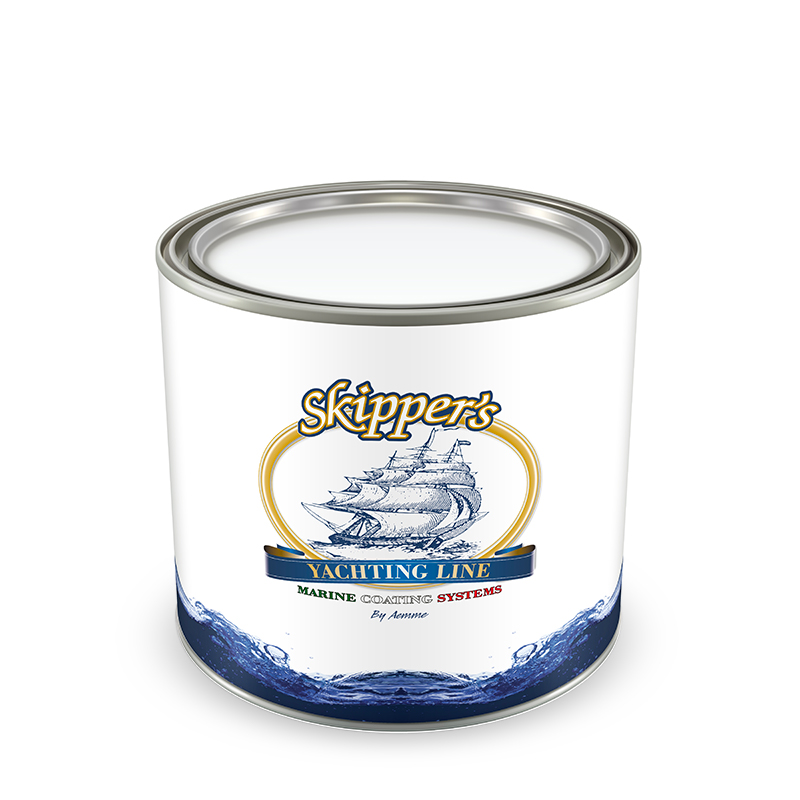

Semi-gloss textured white finish with excellent properties of flexibility and weather resistance in marine environment. Performs a non-yellowing "orange-peel" finish particularly recommended for topsides and superstructures of yachts and where it may be necessary to reduce surface uneveness or surface imperfections. For spray application a special spray equipment for “orange-peel” finish must be used. The “orange peel” grade can be adjusted by regulating the percentage of thinning (the higher the dilution and the smoother the orange peel effect ).
SURFACE PREPARATION AND APPLICATION PROCEDURE
Bare Steel. Onto sandblasted steel according to SA 2,5 apply one coat of EPOFOND AM-9. If sandblasting would not be possible degrease the surface and remove any trace of corrosion providing a suitable anchor pattern. Any loose paint should be meccanically removed. Apply 2 coats of EPOFOND AM-9 primer and let dry. Fill up if necessary with PLAMUR FINISHER MDF. Apply then one coat of POLIFOND primer, let dry for 24 hours and sandpaper. Overcoat with 2 coats of WHITEXT BUCCIATO allowing 18-24 hours between coats.
Fibreglass. The surface to be coated should be degreased with suitable cleaner, rinsed and slightly sanded with fine abrasive paper. Remove dust and clean the surface. If the surface is slightly powdering it is necessary to apply one coat of POLIFIBER PRIMER allowing 18-24 hours between coats. Fill up if necessary with PLAMUR FINISHER MDF. Overcoat with 2 coats of WHITEXT BUCCIATO allowing 24 hours between coats.
Bare Wood. The surface should be clean, dry and well seasoned. If required apply a sealing coat of POLIGLASS VARNISH diluted 50% or more with THINNER 203. After 24 hours sandpaper and apply 2 coats of WHITEXT BUCCIATO allowing 24 hours between coats.
Previously painted wood. Proceed with a patch test on a small area of the coated surface to verify if the old paint is compatible and to make sure that the old coating is still in sound condition. If the old coating is in good conditions and of 2-pack polyurethane nature, apply then one coat of POLIFOND and let dry for 12-24 hours. Sandpaper and overcoat with 2 coats of WHITEXT BUCCIATO allowing 18-24 hours between coats.
In the case of loose or powdery paint or if not compatile it is recommended that the old paint should be removed completely down to bare wood and that application directions as described above for bare wood be followed.
| Paint Type | Two components |
| Binder type A | Poliurethane-polyester |
| Binder type B | Aliphatic Isocyanate |
| Code & colour A | 4P3902 |
| Code & colour B | 8Z903 |
| Specific gravity kg/lt (±0,05) | (A) 1.500 - (B) 0.980 |
| Solids content (volume) ±2 | 40% |
| Viscosity Ford ø 8 at 20°C ±2 | Tixotropico |
| Shelf life +23°C (±2) | 24 months in unopened cans |
| Viscosity Ford (Ø4 a 20°C) | Thixotropic |
| Application | Brush-Roller-Spray |
| Mixing ratio A+B by volume | 3 parts Sol.A with 1 Sol.B |
| Pot life A+B (20°C) | use within 6-8 hours |
| Brush-Roller | 5-10% Thinner 205 for a light orange-peel finish |
| Spray | 5-10% Thinner 203 for a light orange-peel finish |
| Dust dry | 30-40 minutes (20c) |
| Recoat time | 24 h (20°c) |
| Application temperature | Between +10 C and +40 C |
| Relevant humidity | Less than 80% |
| Dry film thickness advised | 100 microns per coat |
| Theoret. coverage m2/Lt | 5-6 |
Colors: BIANCO
Color code: 4P3902
Before starting paint application please carefully read all the safety precautions indicated on the label of each can or in the product safety data sheet available on request. For further information please do not hesitate to contact our technical staff.
The above information is given to the best of our current knowledge, however, because the conditions of use of our products are beyond our control, no warranty is given or to be implied in respect of such information. Our technical staff can be contacted to study customer's specific requirements involving our products in order to enable their most effective use. Dilution rates and drying times must be considered only indicative, mainly related to a temperature of 20 ° C (68°F) and may vary according to prevailing temperature, in presence of particular weather conditions or depending on application procedures.